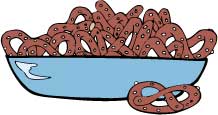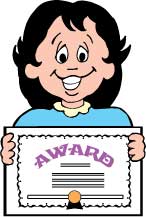To help your class see how mathematics is an integral part of everyday life (and to show your students that you can empathize with those who may be struggling with math), read aloud the poem Arithmetic by Carl Sandburg. Here are few lines:
Arithmetic
Arithmetic is where numbers fly like pigeons in and out of your
head . . .
Arithmetic is numbers you squeeze from your head to your hand
to your pencil to your paper till you get the answer.
Arithmetic is where the answer is right and everything is nice and
you can look out of the window and see the blue sky — or the
answer is wrong and you have to start all over and try again
and see how it comes out this time.
If you take a number and double it and double it again and thenRead the rest of the poem at AllPoetry.com. You may want to have your students write their own poems about their love of or struggles with math. Or have them write about how they use math each day of their lives (even when not at school).
double it a few more times, the number gets bigger and bigger
and goes higher and higher and only arithmetic can tell you
what the number is when you decide to quit doubling.
Excel Math lessons help students relate math to everyday life. Students become confident in mathematics as they progress through the Excel Math system and are better prepared for higher-order thinking skills and advanced math education. In fact, many students develop a love for math! Take a look at our proven lessons for Kindergarten through Grade 6 at www.excelmath.com. More than just worksheets, these lessons really work!
Today and tomorrow, the national finals of the annual Poetry Out Loud contest are being held at George Washington University. Created by the National Endowment for the Arts and the Poetry Foundation, Poetry Out Loud brings together students from all 50 states, the District of Columbia, the U.S. Virgin Islands, and Puerto Rico. Over 375,00 students representing more than 2,000 schools compete in poetry recitation competitions all year long. The top 50 or so finalists travel to Washington D. C. to compete for the top poetry-recitation honors (and these poems have to be memorized). The finals are broadcast only as they occur, so you may want to organize a viewing party. You can watch the live webcast at www.arts.gov. Read more . . .
You may want to read to your class one or two of these clever poems listed on the Poetry Foundation website:
A Teacher’s Lament by Kalli Dakos
Mrs. Stein by Bill Dodds
The Creature in the Classroom by Jack Prelutsky
Freddie by Phil Bolsta
An Equation for My Children by Wilmer Mills
Prof of Profs by Geoffrey Brock
Or this classic from Walt Whitman:
I Hear America Singing
I hear America singing, the varied carols I hear,
Those of mechanics, each one singing his as it should be blithe and strong,
The carpenter singing his as he measures his plank or beam,
The mason singing his as he makes ready for work, or leaves off work,
The boatman singing what belongs to him in his boat, the deckhand singing on the steamboat deck,
The shoemaker singing as he sits on his bench, the hatter singing as he stands,
The wood-cutter’s song, the ploughboy’s on his way in the morning, or at noon intermission or at sundown,
The delicious singing of the mother, or of the young wife at work, or of the girl sewing or washing,
Each singing what belongs to him or her and to none else,
The day what belongs to the day—at night the party of young fellows, robust, friendly,
Singing with open mouths their strong melodious songs.
The Poetry Out Loud competition has an online list of those poems eligible for the 2012-2013 Poetry Out Loud competition. This list is a great poetry resource, searchable alphabetically or by author.
Let us know how you incorporate poetry in your classes. Share a comment in the box below and tell us the grade level(s) you teach.
Excel Math lessons for Kindergarten through Grade 6 help build confident, successful math students. Learn more and take a look at samples at www.excelmath.com. Read the glowing reports from administrators, teachers and parents: http://excelmath.com/about/successes.html.
Those of mechanics, each one singing his as it should be blithe and strong,
The carpenter singing his as he measures his plank or beam,
The mason singing his as he makes ready for work, or leaves off work,
The boatman singing what belongs to him in his boat, the deckhand singing on the steamboat deck,
The shoemaker singing as he sits on his bench, the hatter singing as he stands,
The wood-cutter’s song, the ploughboy’s on his way in the morning, or at noon intermission or at sundown,
The delicious singing of the mother, or of the young wife at work, or of the girl sewing or washing,
Each singing what belongs to him or her and to none else,
The day what belongs to the day—at night the party of young fellows, robust, friendly,
Singing with open mouths their strong melodious songs.
The Poetry Out Loud competition has an online list of those poems eligible for the 2012-2013 Poetry Out Loud competition. This list is a great poetry resource, searchable alphabetically or by author.
Let us know how you incorporate poetry in your classes. Share a comment in the box below and tell us the grade level(s) you teach.
Excel Math lessons for Kindergarten through Grade 6 help build confident, successful math students. Learn more and take a look at samples at www.excelmath.com. Read the glowing reports from administrators, teachers and parents: http://excelmath.com/about/successes.html.




































